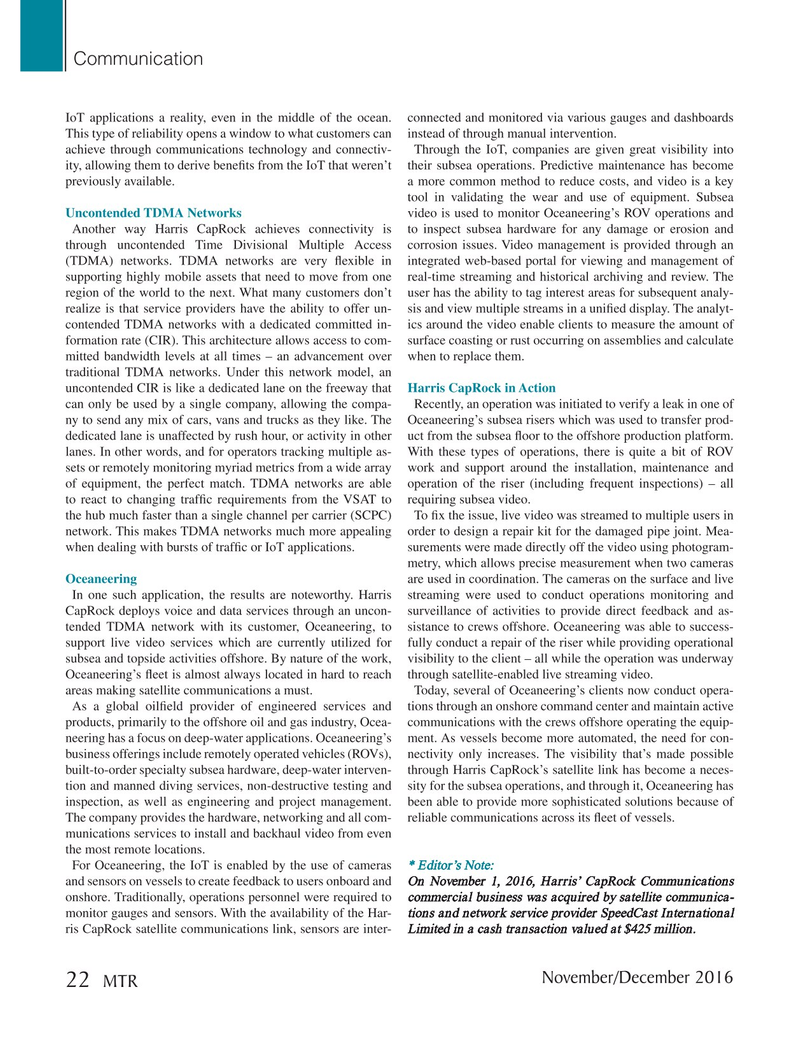
Page 22: of Marine Technology Magazine (November 2016)
Subsea Engineering & Construction
Read this page in Pdf, Flash or Html5 edition of November 2016 Marine Technology Magazine
Communication
IoT applications a reality, even in the middle of the ocean. connected and monitored via various gauges and dashboards
This type of reliability opens a window to what customers can instead of through manual intervention. achieve through communications technology and connectiv- Through the IoT, companies are given great visibility into ity, allowing them to derive bene? ts from the IoT that weren’t their subsea operations. Predictive maintenance has become previously available. a more common method to reduce costs, and video is a key tool in validating the wear and use of equipment. Subsea
Uncontended TDMA Networks video is used to monitor Oceaneering’s ROV operations and
Another way Harris CapRock achieves connectivity is to inspect subsea hardware for any damage or erosion and through uncontended Time Divisional Multiple Access corrosion issues. Video management is provided through an (TDMA) networks. TDMA networks are very ? exible in integrated web-based portal for viewing and management of supporting highly mobile assets that need to move from one real-time streaming and historical archiving and review. The region of the world to the next. What many customers don’t user has the ability to tag interest areas for subsequent analy- realize is that service providers have the ability to offer un- sis and view multiple streams in a uni? ed display. The analyt- contended TDMA networks with a dedicated committed in- ics around the video enable clients to measure the amount of formation rate (CIR). This architecture allows access to com- surface coasting or rust occurring on assemblies and calculate mitted bandwidth levels at all times – an advancement over when to replace them. traditional TDMA networks. Under this network model, an uncontended CIR is like a dedicated lane on the freeway that Harris CapRock in Action can only be used by a single company, allowing the compa- Recently, an operation was initiated to verify a leak in one of ny to send any mix of cars, vans and trucks as they like. The Oceaneering’s subsea risers which was used to transfer prod- dedicated lane is unaffected by rush hour, or activity in other uct from the subsea ? oor to the offshore production platform. lanes. In other words, and for operators tracking multiple as- With these types of operations, there is quite a bit of ROV sets or remotely monitoring myriad metrics from a wide array work and support around the installation, maintenance and of equipment, the perfect match. TDMA networks are able operation of the riser (including frequent inspections) – all to react to changing traf? c requirements from the VSAT to requiring subsea video.
the hub much faster than a single channel per carrier (SCPC) To ? x the issue, live video was streamed to multiple users in network. This makes TDMA networks much more appealing order to design a repair kit for the damaged pipe joint. Mea- when dealing with bursts of traf? c or IoT applications. surements were made directly off the video using photogram- metry, which allows precise measurement when two cameras
Oceaneering are used in coordination. The cameras on the surface and live
In one such application, the results are noteworthy. Harris streaming were used to conduct operations monitoring and
CapRock deploys voice and data services through an uncon- surveillance of activities to provide direct feedback and as- tended TDMA network with its customer, Oceaneering, to sistance to crews offshore. Oceaneering was able to success- support live video services which are currently utilized for fully conduct a repair of the riser while providing operational subsea and topside activities offshore. By nature of the work, visibility to the client – all while the operation was underway
Oceaneering’s ? eet is almost always located in hard to reach through satellite-enabled live streaming video.
areas making satellite communications a must. Today, several of Oceaneering’s clients now conduct opera-
As a global oil? eld provider of engineered services and tions through an onshore command center and maintain active products, primarily to the offshore oil and gas industry, Ocea- communications with the crews offshore operating the equip- neering has a focus on deep-water applications. Oceaneering’s ment. As vessels become more automated, the need for con- business offerings include remotely operated vehicles (ROVs), nectivity only increases. The visibility that’s made possible built-to-order specialty subsea hardware, deep-water interven- through Harris CapRock’s satellite link has become a neces- tion and manned diving services, non-destructive testing and sity for the subsea operations, and through it, Oceaneering has inspection, as well as engineering and project management. been able to provide more sophisticated solutions because of
The company provides the hardware, networking and all com- reliable communications across its ? eet of vessels. munications services to install and backhaul video from even the most remote locations.
For Oceaneering, the IoT is enabled by the use of cameras * Editor’s Note: and sensors on vessels to create feedback to users onboard and On November 1, 2016, Harris’ CapRock Communications onshore. Traditionally, operations personnel were required to commercial business was acquired by satellite communica- monitor gauges and sensors. With the availability of the Har- tions and network service provider SpeedCast International ris CapRock satellite communications link, sensors are inter- Limited in a cash transaction valued at $425 million.
November/December 2016 22
MTR
MTR #9 (18-33).indd 22 MTR #9 (18-33).indd 22 12/7/2016 2:52:34 PM12/7/2016 2:52:34 PM

 21
21

 23
23
